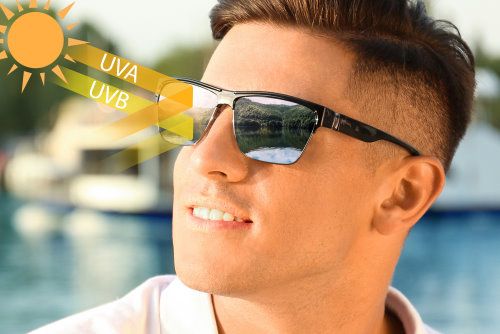Introduction to UV Radiation and Eye Health
Ultraviolet (UV) radiation is a form of electromagnetic radiation from the sun and artificial sources like welding machines and tanning beds. It is invisible to the human eye and is classified into three types based on wavelength: UV-A, UV-B, and UV-C. The ozone layer absorbs UV-C and does not reach the earth’s surface. However, UV-A and UV-B can penetrate the atmosphere and affect human health.
The sun, with its warm and radiant glow, is undoubtedly a life-giving force, providing light and energy to our planet. However, while basking in the sun’s glory can be delightful, it’s essential to remember that prolonged and unprotected exposure to the sun’s harmful ultraviolet (UV) rays can pose severe threats to our health. In particular, the delicate and sensitive organs that are our eyes are susceptible to damage from UV radiation. To shield our eyes from these harmful rays, UV-blocking sunglasses have emerged as a crucial accessory. This article explores the importance of UV-blocking sunglasses, their impact on eye health, and considerations for choosing the right pair.
UV-A has a longer wavelength and is less energetic than UV-B. It makes up about 95% of the UV radiation that reaches our skin and eyes. UV-A can pass through the cornea and reach the lens and retina inside the eye. Overexposure to UV-A has been linked to the development of certain types of cataracts, and research suggests it may play a role in the development of macular degeneration, a leading cause of blindness in older adults.
UV-B, with shorter wavelengths and more energy than UV-A, can damage the cornea and the lens on the front surface of the eye. It is more intense and causes damage more quickly than UV-A radiation. Exposure to UV-B radiation is linked to photokeratitis, a painful inflammation of the cornea, similar to sunburn but affecting the eyes. It can also contribute to the development of cataracts and other eye conditions.
Given the harmful effects of UV radiation on the eyes, it is crucial to protect them from overexposure. Prolonged exposure to UV rays without proper protection can lead to severe eye conditions and damage. Wearing UV-blocking sunglasses and wide-brimmed hats can significantly reduce the risk of UV-related eye conditions. It is essential to take precautions during outdoor activities and in environments with reflective surfaces like water, snow, and sand, as they can increase UV exposure. Protecting your eyes from UV radiation is an essential step in maintaining eye health and preventing vision impairment and eye diseases.
Dangers of UV Exposure to Eyes
Ultraviolet (UV) radiation, while invisible to the human eye, poses significant health risks. One of the immediate effects of excessive UV exposure is photokeratitis, a painful eye condition that can be considered a sunburn of the eyes. It occurs when the cornea, the clear front surface of the eye, absorbs too much UV-B radiation. Symptoms include redness, a gritty eye feeling, extreme sensitivity to light, and excessive tearing. Fortunately, these symptoms are usually temporary and resolve independently with time and proper care.
However, the long-term effects of UV exposure can be much more severe and lead to chronic eye conditions. Prolonged exposure to UV rays has been linked to the development of cataracts, a clouding of the eye’s lens that can lead to blindness if left untreated. UV exposure can also contribute to the growth of pterygium, a benign but potentially bothersome growth on the eye’s surface that can alter its shape, causing astigmatism and vision problems.
Eye cancer is another serious risk associated with UV exposure. Melanoma, the most dangerous form of skin cancer, can also occur in the eye. Another long-term effect of UV exposure is macular degeneration, a condition affecting the macula, the part of the retina responsible for clear central vision. Over time, macular degeneration can lead to vision loss.
Personal stories, like that of a surfer who developed pterygium after years of exposure to the reflective UV rays of the water, highlight the importance of wearing protective eyewear. Another case involves a mountain climber who experienced temporary blindness due to intense UV exposure at high altitudes. These stories underscore the critical need for awareness and protective measures to safeguard our eyes from the hidden dangers of UV radiation.
The Impact of UV Radiation on Eye Health
Prolonged exposure to UV radiation, especially UVB and UVA, can have a significant impact on eye health. Here are some of the adverse effects:
Cataracts: Cataracts are the clouding of the eye’s natural lens, which leads to blurry vision and eventually blindness. UVB radiation is a known risk factor for cataract formation, and it is estimated that up to 10% of cataract cases are attributable to UV exposure.
Macular Degeneration: Age-related macular degeneration (AMD) is a leading cause of vision loss in the elderly. Studies suggest that chronic exposure to UVA and UVB rays may increase the risk of AMD. The macula, the central part of the retina responsible for detailed vision, is particularly vulnerable to UV damage.
Pterygium: Pterygium is a growth of tissue on the white of the eye that can extend onto the cornea. UV radiation is a well-established cause of pterygium, and it often occurs in people who spend significant time outdoors without eye protection.
Photokeratitis: Photokeratitis, sometimes called “snow blindness,” is a painful condition caused by intense UVB exposure, such as sunlight reflected off snow or water. It results in temporary vision loss, eye pain, and sensitivity to light.
Skin Cancer Around the Eyes: The skin around the eyes is delicate and more susceptible to skin cancer due to frequent sun exposure. UV radiation can contribute to the development of skin cancers in this area, including basal cell carcinoma and squamous cell carcinoma.
The Importance of UV-Blocking Sunglasses
To mitigate the risks associated with UV radiation, UV-blocking sunglasses have become a crucial accessory. Here’s why they are important for maintaining good eye health.
UV Protection: UV-blocking sunglasses are specifically designed to block or absorb harmful UV radiation. They provide a barrier against both UVA and UVB rays, reducing the amount of radiation that reaches the eyes. This protection helps prevent or delay the onset of eye conditions such as cataracts and macular degeneration.
Reduced Glare: Sunglasses are not only about UV protection but also about enhancing visual comfort. They reduce glare from reflective surfaces like water, sand, and road surfaces, making outdoor activities more enjoyable and safer. This reduction in glare can also lower the risk of photokeratitis.
Pterygium Prevention: By shielding the eyes from UV radiation, sunglasses help prevent the development of pterygium, which can be unsightly and uncomfortable. Pterygium removal often requires surgical intervention, making prevention a preferred approach.
Skin Protection: Wearing sunglasses also provides protection to the sensitive skin around the eyes, reducing the risk of skin cancer and premature skin aging. This is particularly important for people who spend a lot of time outdoors.
Choosing the Right UV-Blocking Sunglasses
Selecting the right pair of UV-blocking sunglasses is crucial for protecting your eyes from the harmful effects of UV radiation. It’s not just about style; the effectiveness of sunglasses in protecting your eyes from UV rays depends on several critical factors.
Firstly, ensure that the sunglasses block 100% UV-A and UV-B radiation. This is the most crucial criterion because it ensures that your eyes are fully protected from the harmful effects of UV rays. The labeling on the sunglasses should specify that they offer 100% UV protection. Don’t be deceived by the color or darkness of the lenses, as these do not indicate the level of UV protection.
Secondly, the sunglasses should screen out 75 to 90% of visible light. This range ensures that the lenses are dark enough to protect your eyes from bright light but not so dark that they impair your vision. The fit of the sunglasses is also essential; they should be close-fitting and cover the entire eye area to prevent UV rays from entering from the sides.
When it comes to lens quality and color, opt for lenses free of distortion and imperfections. Gray lenses are preferable for proper color recognition, ensuring you see colors accurately while wearing sunglasses.
For those involved in outdoor work or sports, special considerations are necessary. Choose sunglasses with lenses made from polycarbonate or Trivex material, as these provide the most impact resistance, protecting your eyes from potential hazards.
Lastly, do not overlook the importance of UV protection for children and teenagers. They typically spend more time outdoors than adults, making them more susceptible to UV exposure. Ensure they wear sunglasses that meet the abovementioned criteria, safeguarding their eyes as they enjoy their time in the sun.
Conclusion
Protecting your eyes from the harmful effects of UV radiation is a vital aspect of maintaining good eye health. UV-blocking sunglasses offer a practical and stylish solution to shield your eyes from the sun’s damaging rays. By reducing the risk of conditions such as cataracts, macular degeneration, pterygium, and skin cancer, these sunglasses play a crucial role in safeguarding your vision and overall well-being. When choosing a pair of UV-blocking sunglasses, prioritize those that provide 100% UV protection, fit comfortably, and suit your personal style. Your eyes are precious, and investing in proper eye protection is a step toward a healthier and brighter future.

